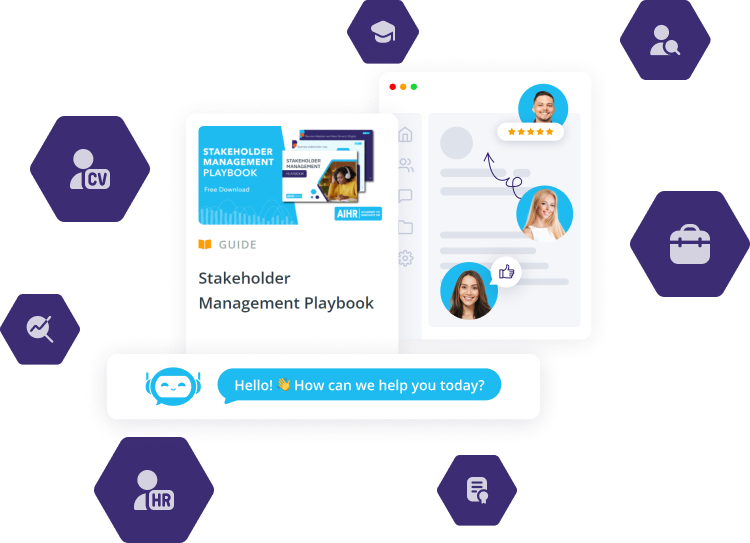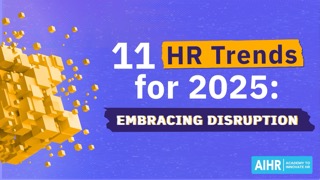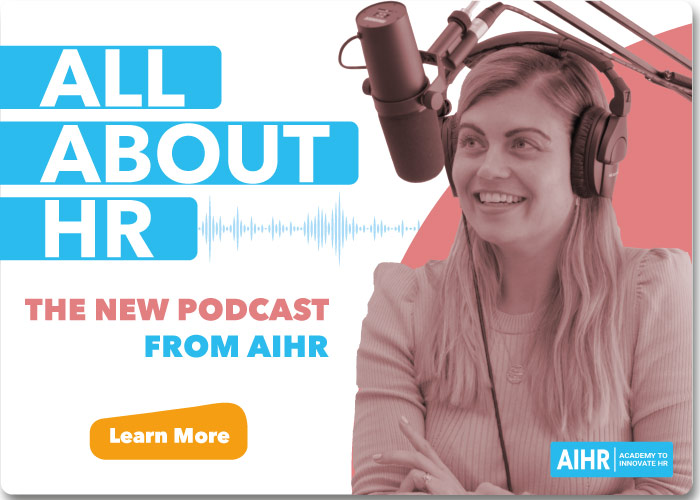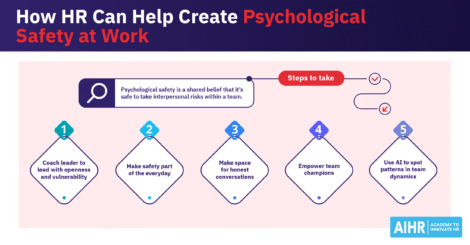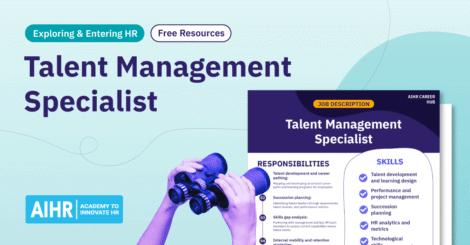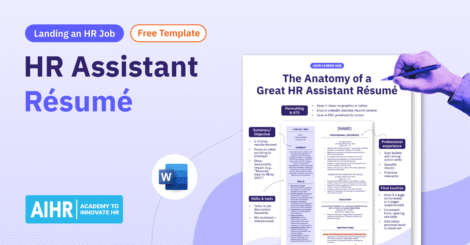An employee transition plan template is one of the most practical tools HR professionals can use to support smooth, structured role changes across an organization.
Transitioning to a new role or organization can be both exciting and stressful for employees. A recent report found that 71% of respondents felt nervous, overwhelmed, stressed, or intimidated.
Managing effective employee transition planning helps create clarity for your employees, boosts retention and engagement, and ensures business continuity.
Contents
What is an employee transition plan?
What role does HR play in employee transition planning?
4 types of employee transition plans
Why use an employee transition plan template?
What should an employee transition plan template include?
Free employee transition plan template
7 steps to ensuring an effective employee transition plan
What is an employee transition plan?
An employee transition plan outlines how responsibilities, knowledge, and tasks will be handed over when an employee changes roles, resigns, takes extended leave, or is promoted or transferred.
A transition plan ensures business continuity. It provides a clear roadmap for knowledge transfer, minimizing disruption to workflows, and aligning timelines and responsibilities across teams.
A transition plan captures critical information like key contacts, ongoing projects, deadlines, and system access. It is a practical, forward-thinking tool that helps HR and line managers maintain operational stability while supporting employees through career movements or temporary absences.
What role does HR play in employee transition planning?
As an HR professional, you can play a central role in developing and overseeing employee transition plans to ensure they are thorough, compliant, and effectively executed. This includes:
- Managing collaboration and timelines: Facilitating collaboration between the departing or transitioning employee, their manager, and relevant team members to define handover priorities, identify critical knowledge, and establish realistic timelines.
- Maintaining proper records: Ensuring that all documentation, including task trackers, process manuals, and system access details, is properly recorded, securely stored, and accessible to the appropriate stakeholders.
- Adhering to regulations: Maintaining compliance with internal policies and labor regulations throughout the transition.
- Mitigating risks: Identifying and mitigating risks like data loss, service gaps, or breaches of confidentiality.
How can HR professionals lead transition planning?
To ensure the right people are placed in the right roles, you will need to move beyond tenure or performance metrics and understand potential, strengths, and fit. This involves:
- Conducting talent audits and succession planning to uncover hidden leadership potential
- Applying competency frameworks and using data-driven tools (like behavioral or cognitive assessments) to evaluate readiness for new roles
- Partnering with line managers to align talent decisions with business strategy and future workforce needs.
Learn to create the talent experience that retains your people
Build your skills in designing career paths, mobility programs, and retention methods that support employee transitions and engagement. Enhance how employees move within and stay with the organization to showcase HR’s human-centric side.
In AIHR’s Talent Management & Succession Planning Certificate Program, you’ll learn to:
- ✅ Build a strong Employer Value Proposition (EVP) and employer brand
- ✅ Identify flight risks and design proactive retention interventions
- ✅ Develop career lattice frameworks and an internal mobility calculator.
This 36‑hour, self-paced online program gives you tools and templates to apply to real employee experience challenges.
👀 Curious if it’s the right fit? You can preview the course lessons before enrolling — no commitment needed.
4 types of employee transition plans
Employee transition plans are not one-size-fits-all. The structure, scope, and focus of each plan will vary depending on the nature of the employee’s movement, whether permanent or temporary, voluntary or business-driven.
By tailoring the approach to the specific type of transition, you can ensure that critical knowledge is retained, responsibilities are clearly reassigned, and operational momentum is preserved.
Here are four common types of employee transitions and what effective planning looks like in each scenario.
1. Resignation or retirement
When an employee resigns or retires, the transition plan should prioritize knowledge transfer and continuity of operations. This includes documenting key processes, identifying unfinished work, handing over responsibilities, and training successors or interim staff. It’s important to reduce the risk of institutional knowledge loss and ensure a stable handover of relationships, systems access, and critical deliverables.
→ Do this: Schedule a structured exit interview and final week knowledge transfer sessions to capture key insights that aren’t found in formal documents.
2. Internal promotion
For employees moving into more senior roles, the focus shifts to delegating their previous responsibilities and preparing for a new scope of work. A transition plan should clarify who will take over their current tasks (either permanently or temporarily) and outline how the promoted employee will gradually shift their attention to new leadership duties. This reduces role overlap or confusion during the change.
→ Do this: Use this transition as an opportunity to upskill or stretch other team members who may be ready for more responsibility.
3. Lateral moves across departments
When an employee moves laterally across departments, the plan should ensure both teams are aligned on expectations, timelines, and knowledge handover. Coordinating with both the current and receiving managers is essential to avoid workload gaps or duplicated efforts. The plan may also include joint onboarding in the new team to support integration.
→ Do this: Set a joint planning session between both departments to map out cross-functional handover tasks and timelines early.
4. Extended leave (maternity, medical, sabbatical)
In cases of planned extended leave, the transition plan should emphasize temporary coverage arrangements, task delegation, and communication protocols. Clear documentation of current responsibilities and deadlines ensures interim team members can step in confidently, while also supporting a smoother reintegration when the employee returns.
→ Do this: Identify a single point of contact or interim lead to consolidate accountability and reduce confusion during the employee’s absence.
Why use an employee transition plan template?
Transition plans help maintain workflow continuity and minimize disruptions. For example, SHRM advises that when managers transition out of roles, a solid exit strategy is crucial to keeping teams productive, positive, and focused. Also, BCG’s research confirms that holistic people strategies, including leadership development, upskilling, and engagement, are fundamental to organizational agility and innovation, and transition plans make sure that workforce capabilities remain aligned with business objectives.
The good news is that using a structured employee transition plan template is one of the simplest ways HR teams can ensure smooth, consistent, and well-documented role changes across the organization to support continuity.
Here are the key reasons to incorporate a transition plan template into your HR toolkit:
- Save time: A template eliminates the need to start from scratch for each transition, letting HR and managers quickly generate a tailored transition plan or transition document.
- Ensure consistency: Standardized templates promote uniformity across departments and types of transitions, helping organizations maintain quality and fairness in their processes.
- Reduce risk of oversight: With predefined fields and prompts, templates help ensure no critical information, deadlines, or system access details are overlooked.
- Support a smoother employee experience: A clear and well-organized transition plan makes the process less stressful for the departing or transitioning employee, as well as for those assuming their responsibilities.
- Improve handovers and onboarding: Templates help capture key responsibilities, contacts, and contextual knowledge in one document, making it easier for successors or interim staff to take over effectively.
- Provide clarity for managers and teams: A structured transition document makes it easier for managers to oversee the process, allocate resources, and communicate expectations to the wider team.
- Encourage accountability: A template helps prevent delays, confusion, and gaps in ownership by outlining who is responsible for which tasks during the transition.
- Strengthen compliance and audit readiness: Documenting the transition process in a consistent format makes it easier to demonstrate compliance with labor laws, internal controls, and exit procedures.
- Track trends and improve processes: Repeated use of a standard template lets HR analyze patterns, gather feedback, and refine transition strategies over time.
- Support succession planning: Even when transitions are temporary or unexpected, having a clear record of duties and skills can support broader workforce planning and internal mobility.
What should an employee transition plan template include?
An effective employee transition plan template provides a clear, structured framework for handing over responsibilities and ensuring continuity when an employee exits, changes roles, or goes on extended leave. A well-designed transition document should include the following key elements:
Employee name and position
Clearly identify the employee who is transitioning, along with their current job title and department.
→ Do this: Use official job titles and department names to ensure accurate record-keeping and alignment with internal systems.
Last working day or transition date
Specify the date on which the transition will take place — whether it’s the last day of work, the start of a new role, or the beginning of a leave period.
→ Do this: Confirm this date with HR and the line manager before finalizing the plan to avoid misalignment.
Summary of key responsibilities
Provide an overview of the employee’s core duties and recurring tasks to give successors or interim staff a clear understanding of the role.
→ Do this: Focus on responsibilities that are critical to business operations and not easily paused or reassigned.
Current projects and status
List all active projects, including descriptions, current progress, deadlines, and any associated documentation or tools.
→ Do this: Use project names and status indicators (e.g., in progress, awaiting approval, on hold) to give a snapshot of ongoing work.
Contacts and stakeholders
Identify internal and external contacts the employee regularly works with, such as clients, vendors, or cross-functional colleagues.
→ Do this: Include full names, roles, email addresses, and notes on the nature of each relationship (e.g., daily updates, monthly reporting, decision-maker).
Handover instructions or documentation links
Include detailed instructions on how to perform key tasks or access relevant information, along with links to SOPs, folders, or knowledge bases.
→ Do this: Store documents in shared, secure platforms and test all links to ensure they’re accessible and up to date.
Successor or interim contact
Name the person or team who will be taking over the responsibilities, whether temporarily or permanently, along with their contact details.
→ Do this: Confirm this handover with the individual(s) beforehand and ensure they understand what’s expected of them.
Approvals and sign-offs
Include a section for the outgoing employee, their manager, and HR to sign off on the transition plan, confirming that all key areas have been addressed.
→ Do this: Make this part of your formal offboarding or role change process to ensure accountability.
Training needs for successors (optional)
Outline any training, shadowing, or onboarding support the successor may need to step confidently into the role.
→ Do this: Schedule knowledge transfer or mentoring sessions before the transition date, especially for technical or role-specific knowledge.
Post-transition check-ins (optional)
Plan for a follow-up after the transition, such as a check-in with the successor or a review of handover effectiveness.
→ Do this: Set calendar reminders for 2–4 weeks post-transition to identify any gaps early and make adjustments if needed.
Free employee transition plan template
Download our free employee transition plan template to simplify and standardize your handover process. This customizable template is designed to help HR professionals, managers, and team leads capture the essential information needed for smooth role transitions. Use it as a starting point to build clear, consistent transition documents that reduce disruption and support business continuity.
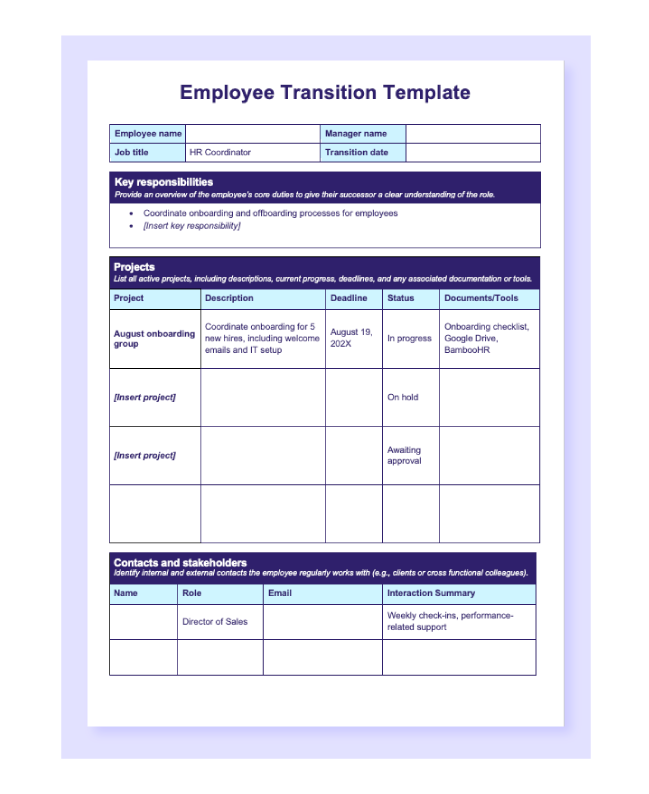
Free succession planning template
AIHR also offers a free succession planning template that you can customize to suit your company’s needs and culture, and streamline your succession planning process. Download it to help you create a clear view of leadership pipelines and assess the progress of potential successors.
7 steps to ensuring an effective employee transition plan
Creating a structured and well-executed employee transition plan is essential to maintaining continuity, minimizing disruption, and supporting both the outgoing and incoming team members. Here’s how to create a transition plan that works in seven simple steps.
1. Identify the transition event
Start by clearly defining the nature of the transition: is the employee resigning, being promoted, transferring laterally, or taking extended leave? Understanding the reason and scope of the change will shape how detailed the transition document needs to be and what areas require focus, whether it’s long-term handover planning or short-term coverage.
HR tip: Don’t wait until a final exit interview; early identification supports proactive planning.
2. Notify relevant stakeholders and schedule planning discussions
Once the transition is confirmed, inform key stakeholders, like the employee’s manager, team members, HR business partners, and IT or payroll, if needed, and schedule planning sessions to map out timelines, responsibilities, and any potential risks.
HR tip: Use this opportunity to align everyone on expectations and avoid last-minute confusion.
3. Choose and adapt a transition plan template
Select an employee transition plan template that suits your organization’s structure and the type of transition underway. A good template provides a standardized format for capturing essential information while allowing flexibility for different scenarios.
HR tip: Adapt the template with custom sections (e.g., client handovers, compliance notes, or return-to-work plans) as needed.
4. Collaborate with the employee and manager to complete it
Work with the transitioning employee and their manager to complete the transition plan in full. This should include responsibilities, active projects, key contacts, and any supporting documentation or systems access.
HR tip: Encourage the employee to flag undocumented knowledge or routines that may not appear in formal SOPs.
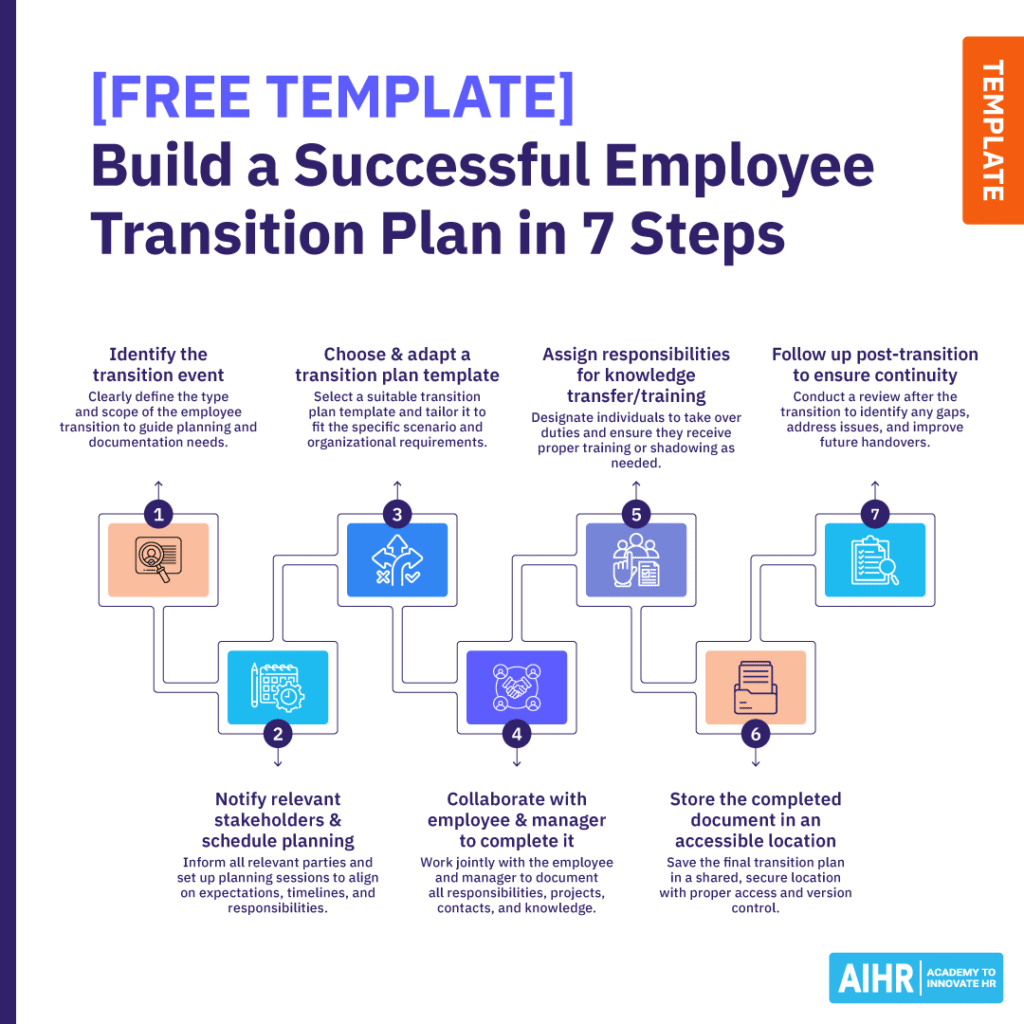
5. Assign responsibilities for knowledge transfer or training
Identify who will take over each employee’s duties (permanently or temporarily) and organize any required training or shadowing. It’s also important to clarify accountability for each handover item to ensure a seamless transfer.
HR tip: Prioritize high-risk or high-impact responsibilities first, especially in client-facing or compliance-heavy roles.
6. Store the completed document in an accessible location
Once finalized, store the transition document securely in a shared, centralized location (like an internal HR system, team drive, or project management platform) where all relevant parties can access it.
HR tip: Avoid storing the plan in the employee’s personal drive or inbox, and make sure you have version control and clear access permissions.
7. Follow-up post-transition to ensure continuity
Schedule a post-transition review two to four weeks after the handover and check in with the successor, manager, and team to identify any outstanding issues, gaps in information, or training needs that may have emerged.
HR tip: Use this feedback to improve future transition planning and refine your templates or processes over time.
To sum up
Don’t think of this as a checklist. An effective employee transition plan is a strategic tool that protects business continuity, preserves institutional knowledge, and supports a smooth experience for everyone involved. Whether the transition is due to a resignation, promotion, departmental shift, or extended leave, having a clear, consistent process in place ensures that responsibilities are handed over seamlessly, key information is retained, and teams remain aligned throughout the change.
Knowing how to create a transition plan using a standardized template is critical to managing transitions efficiently and with minimal disruption. With proactive planning, collaboration, and thoughtful follow-through, each employee movement becomes an opportunity to strengthen operations, grow internal capability, and demonstrate a professional, people-first approach to change.


